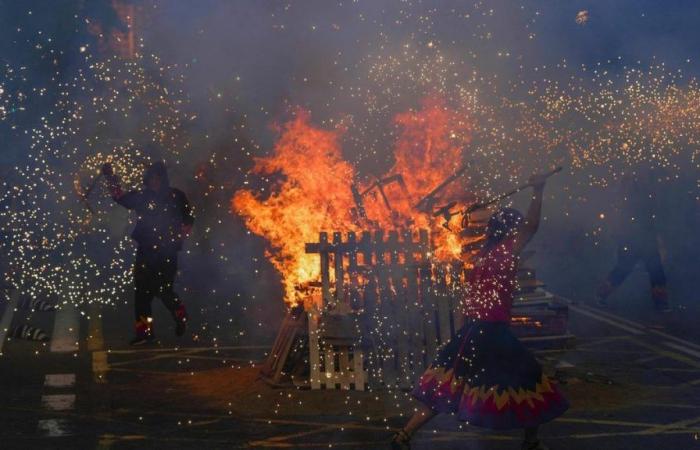
“The years pass, yes, / The fire does not: / The fire will return in the children of the sun,” he sings. Silvio Rodriguez. These verses belong to There are those who need, a song in which fire is that great fire that renews a life that is not always easy to continue living. Curiously, Rodríguez does not mention fire in Summer night Dreama Shakespearean title song that refers to the Summer Solsticethat pagan festival that today we make coincide with the San Juans night. As in the English playwright’s comedy, Rodríguez’s song alludes to a dream that turns into a nightmare – “If I think that I was made / To dream the sun / And to say things / That they awaken love / how is it possible then / Let him sleep between jumps /Of anguish and horror?”-, a dream from which it is better to wake up.
“Midnight has sounded with an iron tongue. /Lie down, lovers: it’s fairy time. /In the morning, I suspect, we will sleep /all that we have watched this night,”, Theseus sings in the final scene of The dream of a nigth of summer. The night of love affairs has come to an end; They have been hours in which everyone has been awake, debating and falling in love with who they shouldn’t have. With the day, the dream comes to an end and each person ends up with their corresponding lover. The night has been a kind of transitiona space-time framework of dream and magic in which unrequited loves have found an answer.
As in Rodríguez’s verses, in the Shakespeare comedyset in a forest near Athens ruled by Theseus, the action takes place during the San Juans nightso often defined as the most magical night of the yearin which different ritualsstarting with lighting bonfires, to leave the bad behind. “At the time when dreams become true / at dawn / I saw the lips open / petal by petal,” he writes Yorgo Seferis, because, this night of dreams, fantasies and magic is also a night of clairvoyance. Hence, the Greek poet reminds us, with the arrival of the day also comes “the pain of the resurrection.”
The wishes of a night that soon ends
“The summer solstice, or the solstice day, is the great moment of the solar course in which, after rising day after day through the sky, the luminary stops and from then on retraces its steps on the celestial path,” he explains. the anthropologist James George Frazer in The golden branch. “This moment could not help but be considered with anxiety by primitive man as soon as he began to observe and ponder the careers of the great luminaries through the celestial vault; having yet to learn to realize his impotence in the face of immense cyclic changes of nature, could dream of helping the sun in its apparent decline; that could support him in his failing steps and rekindle the dying flame of the reddish lamp in his weak hands.
In the anxiety to contemplate the slow retreat of the sun and in the confidence in being able to sustain it lie, in Frazer’s opinion, the ancestral rites and the celebrations associated with the longest day of the yearrituals and celebrations in which the fire almost immediately takes center stage. The fire was a symbol of a past that burns forever, but also of a rebirth. In fact, many of these rites served to make the lands more fruitfulso that the fields would give better and more abundant harvests.
The farmers of Upper Bavaria, says Frazer, “extinguished the fire in their home and rekindled it with brands and embers taken from the bonfire of the Summer Solstice. “People judged the height to which the flax would grow that year by the height to which the flames of the bonfire would rise.” From desires directed at the earth we moved on to desires directed at oneself: a past that one wanted to leave behind was burned and people sang and danced to fulfill future desires. There was hope, but also bitterness for what had been experienced or for what had been desired and that had not been fulfilled until then.
“On the night of June 23, 1956, verbena San Juanthe call poshapart He emerged from the shadows of his neighborhood dressed in a brand new tan summer suit; He walked down the Carmel road to Plaza Sanllehy, jumped on the first motorcycle that he saw parked and that offered certain guarantees of impunity (& mldr;) and rushed through the streets towards Montjuic at full speed. so it begins Last afternoons with Teresa. Juan Marsé begins the adventures of poshapart precisely one San Juans night; Its protagonist, instead of going to Montjuïc, ends up heading to the wealthy Barcelona neighborhood of Sant Gervasi: “With the engine idling, breathing in the fragrant June night loaded with vague promises, he drove through deserted streets, flanked by fences and gardens,” he tells us. says Marsé, thus describing the exclusive streets of that neighborhood where Teresa lives and to which Pijoaparte aspires.
Her journey from Mount Carmel to San Gervasio is full of hope, although all of them tinged with cynicism, in the same way that the last journey, the one that takes Teresa on this occasion from San Gervasi to Montjuïc, is impregnated with desolation, after When she found out about the arrest of poshapart. Two journeys in reverse that represent precisely that pain that Seferis alluded to: the novel begins with the magical night, the night of dreams, and ends during the day, when those dreams, converted as he would say Shakespeare in a nightmare, they come to an end giving rise to a transformed reality –Teresa She is no longer the young woman at the beginning of the novel and poshapart is discovered – and not necessarily for the better.
A transformative night
“I don’t want to sleep, I don’t want to sleep anymore. “I always want to go out at night,” Elsa thinks. She is the only one who does not observe the fireworks that illuminate during the verbena San Juan the sky that describes us from the rooftops Francisco Casavella in Watusi day. Like her author, Elsa is also on top of a rooftop and, unlike her neighbors, who hug, kiss and empty the last bottles they have left, Elsa is lost in thought, but not in front of the fires, but observing the people around her that she doesn’t seem to recognize.
As Miqui Otero points out in the epilogue of the Anagrama edition, a hasty or lazy reading leads one to think “that the important thing about Elsa’s entire sleepy tirade on the roof is that the night does not break and it does not yet dawn if you lower the blinds.” ;. However, “that fascination with skull curses prevents us from appreciating the gesture: when everyone looks at the Fireworks“She watches how those luminous tinsels change the people who look at them.” Therefore, Otero concludes, Elsa, like Casavella himself, looks at what others ignore. For this reason, your look is tinged with melancholy; For this reason, Elsa insists that she always wants to go out at night, because the end of the night is the arrival of that day from which the fireworks distract.
“In my early age, when I was still looking forward to the holiday, once it was over, staying awake, I sadly hugged the feather pillow, and, late at night, / a song that could be heard going away along the roads / dying little by little in the distance / squeezed my heart just like it does now,” he wrote Giacomo Leopardi. While the verses of the Italian poet express the sadness that comes at night after the party has ended, in the words of Elsa, as well as in the verses of Seferis, we find the melancholy for a night that, when it ends, ends. will reveal like a parenthesis from which no one emerges unscathed.
We see it in the melancholic clairvoyance of Elsa and we see it in Rico, the cousin of the protagonist of Simonthe penultimate novel by Miqui Otero. Rico disappears one San Juans night after touring, too, the rooftops of Barcelona, just before the day arrives: “The firecrackers were decreasing with the passing of the hours, as if the laughter of this city was fading. As if he wanted to lengthen it for fear of the awkward silence after each laugh.”
The transgression of the Night of San Juan It does not reside in the party, nor in the fire, nor in the lights of the festival; The transgression of the Night of San Juan is not in the rites themselves, but in the awareness that, as in the Carnival As the literary theorist Bakhtin once described, that night is a moment of rupture with the before, but also with the after. The transgression resides in Elsa’s gaze, who realizes it, or in the conviction of Noa, the protagonist of Electric shamans at the sun festivalthe latest novel by Mónica Ojeda, of not returning to Guayaquil and staying high in the Andes, where she has gone to participate in a macro music festival, precisely on the occasion of the festival of the sun.
At that party, which she doesn’t want to end, there is a vindication of enjoyment, which thus opposes the violence that engulfs the rest of the country. That carnivalesque moment lasts as long as Noa does not want to return to her home, however, it lasts in another space that is opposed to the rest of the country. Noa and Elsa, each in their own way, do not want the day to come back. However, for Elsa that day comes as it also comes for the characters in Shakespeare and for Simón, the protagonist of Otero, who must accept that his cousin is no longer here. Rico disappears and with him that Barcelona in which Simón grows up also begins to disappear, which is San Juans night He begins to leave childhood behind and grow older.





